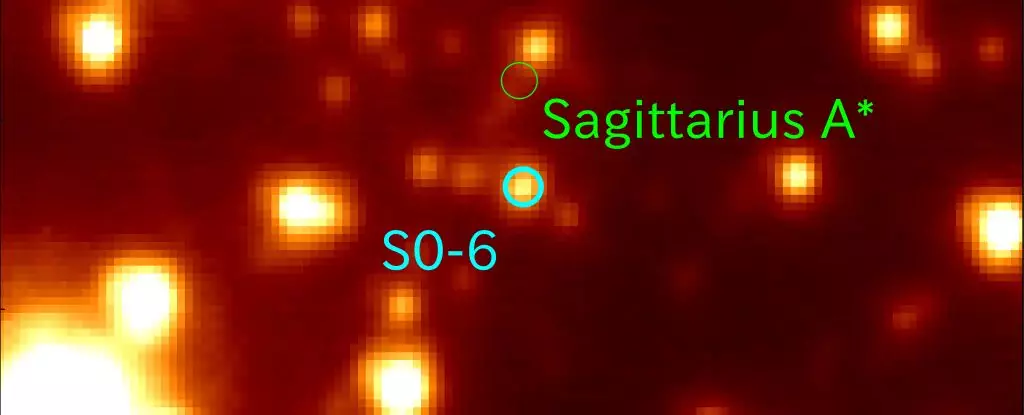The enigmatic S-stars that orbit around the supermassive black hole at the center of the Milky Way continue to captivate astronomers. These stars, including the recent discovery S0-6, challenge our understanding of star formation in extreme galactic environments. Led by astrophysicist Shogo Nishiyama of Miyagi University of Education, a team of researchers has shed some light on the origin of S0-6, revealing that this celestial wanderer hails from outside our own galaxy. This groundbreaking finding makes S0-6 the first star in the galactic center with an extragalactic origin story.
The S-stars exhibit extraordinary characteristics that make them a source of fascination among astronomers. With their long, looping, elliptical orbits around the supermassive black hole known as Sagittarius A*, these stars achieve mind-boggling speeds. In fact, the fastest star ever recorded in the Milky Way is an S-star, reaching velocities of up to 24,000 kilometers (15,000 miles) per second as it swirls around the black hole. Additionally, an S-star played a significant role in the confirmation of general relativity on an unprecedented scale. Consequently, the S-stars provide valuable insights into the complexities of physics.
Determining the origin of S0-6 has been a perplexing challenge. To shed light on this mystery, Nishiyama and his team embarked on an 8-year study of S0-6 using the Subaru Telescope, an optical-infrared observatory located in Hawaii. Their investigation encompassed two primary aspects: measuring the star’s velocity and trajectory, and analyzing its emitted light spectrum.
Through their observations, the researchers confirmed S0-6’s orbit around Sagittarius A* by measuring its acceleration. Astonishingly, S0-6 is positioned a mere 0.04 light-years away from the black hole, highlighting the star’s close proximity to this cosmic giant.
Delving further, the team scrutinized the light emitted by S0-6, specifically searching for distinct lines on its spectrum. These lines result from elements that absorb and emit specific wavelengths of light, providing valuable insight into the star’s chemical composition. Moreover, this composition not only helps estimate the star’s age but also offers clues about its birthplace, as stars born together in the same location tend to possess similar chemical profiles.
By analyzing S0-6’s spectrum, the researchers discovered a low abundance of heavy elements within the star, leading to an estimated age of approximately 10 billion years. However, what truly distinguished S0-6 from other stars in the galactic center was its chemical makeup, which closely resembled stars outside the Milky Way. Particularly, S0-6 shares striking similarities with stars in dwarf galaxies orbiting our own, such as the Sagittarius Dwarf Spheroidal Galaxy and the Small Magellanic Cloud. These dwarf galaxies are undergoing a gradual assimilation into the Milky Way, explaining the presence of their stars within our galactic center. Given the Milky Way’s history of devouring other galaxies throughout its 13.6 billion-year lifespan, the presence of remnants from these dwarf galaxies is not surprising.
While this discovery indicates the possibility of relics from subsumed galaxies migrating towards the galactic center, further confirmatory research is required. Nevertheless, it undoubtedly demonstrates the distinct chemical evolution experienced by S0-6 in comparison to other stars in the vicinity.
As with any groundbreaking discovery, additional research is crucial to deepen our understanding and validate these findings. Questions regarding S0-6’s extragalactic origin remain, urging further investigation. Astrophysicist Shogo Nishiyama raises important queries: Did S0-6 genuinely originate outside the Milky Way? Did it journey alone, or does it have any companions? Unraveling these mysteries will necessitate concerted efforts and continued exploration.
The revelation of S0-6’s extragalactic origin story broadens our knowledge of star formation and migration in the cosmos. Its unique chemical composition, resembling stars in dwarf galaxies currently being assimilated by the Milky Way, establishes the possibility of ancient intergalactic wanderers populating our galactic center. While this discovery marks a significant milestone, it serves as a reminder of how much more the universe has yet to reveal. With ongoing research and technological advancements, the enigma surrounding the S-stars and their origins may unravel, leaving astronomers awe-inspired by the mysteries of the cosmos.


Leave a Reply